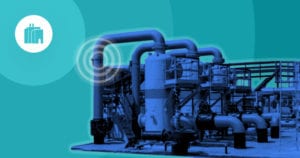
Unplanned downtime is a source of headaches for factories, warehouses, food processing plants and other industrial environments across the globe. Whether you make baked goods, move boxes or manufacture wind turbines, it’s never a good thing when production unexpectedly halts. On top of the cost of repairs is the loss of man-hours, raw materials and product, and it’s estimated that unplanned downtime costs industrial manufacturers $50 billion each year. What’s the best way to avoid unplanned downtime?
Industrial IoT (IIoT), a wireless network of smart sensors and connected devices which captures data insights near the production line and throughout the facility, can help identify when and where there are risks for unplanned downtime. Here are three ways IIoT can help manufacturers avoid unexpected production issues:
1. Identify Preventative Maintenance Opportunities
Many manufacturers determine when to do maintenance on production line equipment based on a machine’s specification guidelines. However, machines can run at different speeds and durations which the guidelines may not take into consideration. The maintenance schedule ends up being a loose estimate for when to perform service and puts you at risk for unplanned downtime. Is there an alternative?
Through a facility-wide IIoT solution, facility and production managers can schedule and perform preventative maintenance on key machinery. One of the ways this can be done is through vibration sensors which measure motor vibration frequency and temperature. If a motor runs at 90 percent capacity for eight hours a day, it’s on pace to need maintenance before a different motor that runs at 70 percent capacity two hours a day. With vibration sensor data, managers can spot potential mechanical issues like misaligned couplings and an unbalanced motor. Once a potential problem is identified, maintenance can be scheduled during off-peak or non-active production times. The threat of unplanned downtime is prevented and production can carry on like normal.
2. Maintain Facility-Wide Conditions for Optimal Productivity
Besides production line machinery hiccups, events like leaks can result in unplanned downtime. Leaks from cracked or burst pipes can shutdown main areas around the production line. A similar incident in an auxiliary area that isn’t occupied every day can be even more hazardous since no one knows it’s there. Unmonitored leaks can cause more damage and eventually make their way to busy main areas and result in unexpected downtime.
Through power metering and flow monitoring, facility managers can monitor pipes and storage tanks for potential water and gas leaks. If a storage tank empties at a quicker rate than an established benchmark, that signals a problem. A flow meter may capture data to indicate liquids are moving out of one pipe at a quicker pace than usual, which can mean there’s a malfunction. With this information, a plan can be made to protect the main production area from damage or disturbance and locate the cause of the leak.
3. Sustain Production and Product Quality to Avoid Delays
In some manufacturing facilities, big shifts in temperature and relative humidity can compromise raw material quality and cause delays to scheduled production. A food and beverage company discovered that each time one of their employees went in and out of the freezer where raw ingredients were stored, the door was left ajar. After a while, the freezer temperature increased to a point where the ingredients were compromised and had to be thrown away. So, production paused until another batch of ingredients was ordered and prepped.
IIoT-compatible temperature and relative humidity smart sensors transmit data to a facility-wide monitoring application. Benchmarks can be created from that data so current trends and anomalies can be accurately measured.
There are a lot of factors in any facility that can wreak havoc and cause unplanned downtime. Machine mishaps, leaks, changes in environmental conditions and more can all bring production to a complete stop. Through IIoT, facility managers can initiate regular preventative maintenance, closely monitor environmental conditions in critical areas, and proactively address unexpected events in the facility before they get worse.





 Related Podcast Episode
Related Podcast Episode




 Related Applications
Related Applications



 Latest IoT News
Latest IoT News









